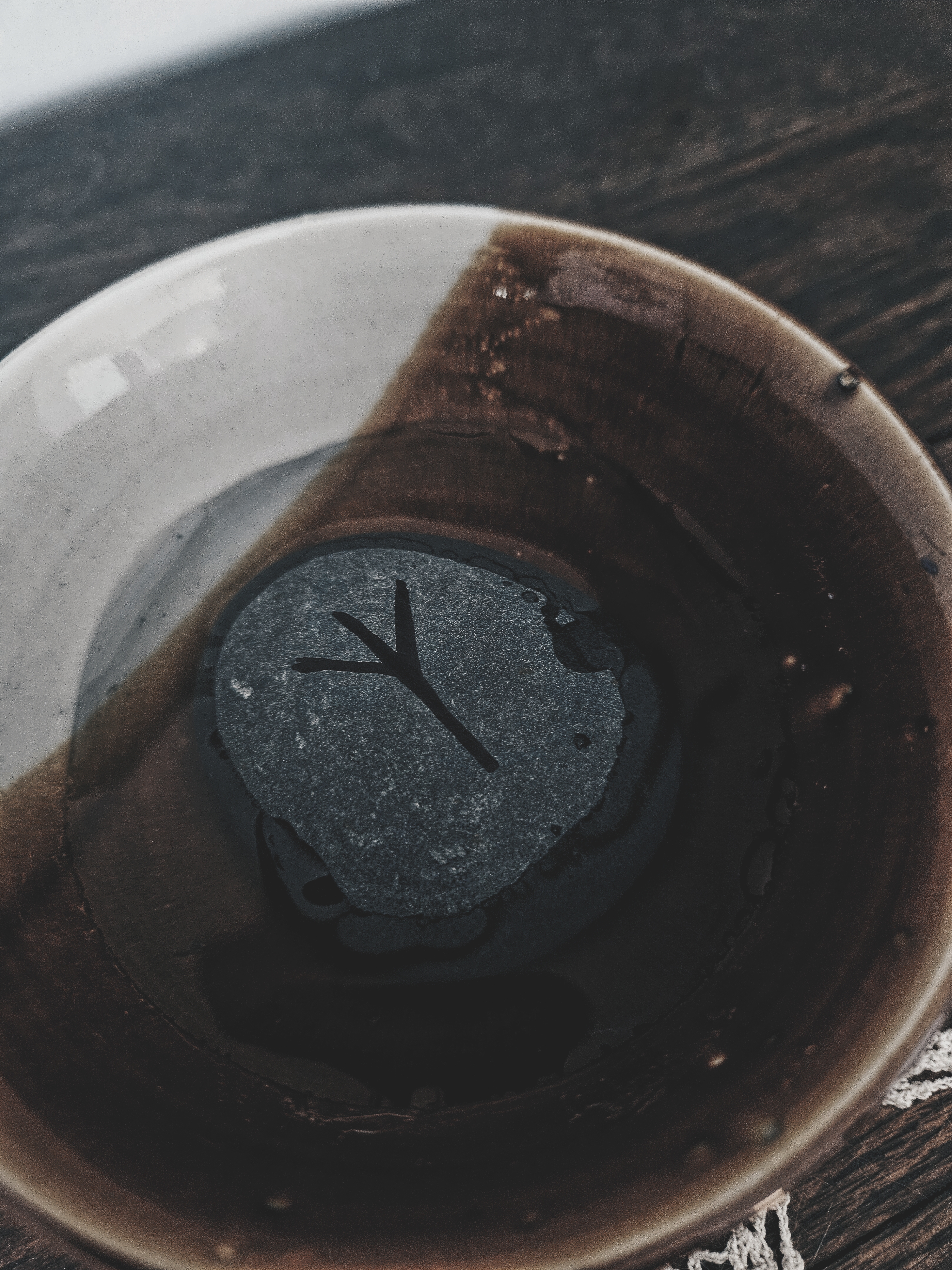"Can you do more earth spells? Like banishing someone from another realm spell? Or just connecting to mother gaia and her energies rituals."
Of course, I can do that, and I decided to start with the first suggestion, banishing someone from another realm. As a hedge witch, it's not uncommon to encounter spirits, beings, and energies in the Otherworld, and while I do my best to protect myself and prevent anything from coming back with me, it sometimes still happens. If something does happen to come back with you, or you notice something otherworldly has attached itself to you through other means, this ritual will help you banish it.
This ritual is for the stubborn entity, the one you have already asked to leave, and isn't responding to other simpler methods of banishment, such as verbally requesting it to go, banging pots and pans, or the burning of banishing herbs.
What You'll Need
- Salt
- Black or dark green candle
- Light or match
- Black tourmaline
- Bowl of soil or access to earth
- Dried rosemary, rue, or black cohosh root
- Charcoal disc
- A written name/sigil/object representing the entity/energy
- A small shovel or spoon
- Bell or chime
- Offering to Mother Gaia, such as honey, wine, or quartz
What to Do
This spell is best performed during the waning moon.
Begin by grounding, centering, and cleansing your space and materials using your preferred methods. Next, draw a circle of salt around your ritual space and place the bowl of soil in front of you and the candle behind it.
Light the candle (and charcoal) and while holding the black tourmaline in your left hand, invoke Mother Gaia by saying, "Mother Gaia, ancient one, ground of being, giver of life; I call upon your strength and stone to cast out what is not my own." Visualize roots reaching deep into you from the black tourmaline and into the ground below you, drawing up Mother Gaia's strength. Feel her strength and perseverance fill you, starting at your feet and gradually spreading throughout the rest of your body.
When you feel filled with Gaia's energy, place your dried herbs on the charcoal disc. While still holding the black tourmaline in your left hand, pick up the written name/sigil/object representing the entity/energy with your right hand and say:
"By Gaia’s roots and ancient stone,
I cast thee out, now me leave alone.
Between this world and that, you fade,
Bound by Earth, the pact is made.
No path remains, no gate shall stand,
I send you back by Gaia’s hand,
To the lands beyond, the hidden realm.
To the lands beyond, the hidden realm.
From rock to root, your thread unwinds,
By sacred soil, all fate unbinds.”
"Sealed by stone and guarded by soil,
May no return disturb or spoil.
With Earth’s embrace, I am now unchained.
Be gone, be gone, and not remain.”
Close the ritual by ringing the bell or chime, snuffing out the candle, and thanking Mother Gaia by saying something like, "Mother of Earth, your work is done. I thank you for your assistance today. I walk in light, the battle is won. So it is, so it shall be." Offer Mother Gaia your offering by placing it outside in her soil.
Leave the burial undisturbed for an entire moon cycle before burying the spell remains away from your home or tossing them down a river.
Warnings/Modifications/Alternatives:
- Remember, visualization is not necessarily seeing an object in your mind, but instead an incorporation of all senses to bring about the object or intention. When visualizing, it's more about creating those feelings than necessarily seeing the object or outcome in our mind.
- This ritual can be performed outside if the entity seems to be attached to you and not your space. There is no need to dig up the spell remains if performed outside. If you decide to perform this ritual outside, bury the spell remains in your backyard or away from your property.
- Do not leave a lit candle or charcoal disc unattended, and always have water or another fire extinguisher nearby.
- If you cannot light candles, a black painted electrical tea light will work just as well.
- If you do not have access to loose herbs, use a banishment incense as a replacement.
- If you cannot burn loose herbs or incense, soak the loose herbs in warm water and sprinkle the water around your space, over yourself, and the burial instead.
- If using rue, handle with care. Rue sap is phototoxic, which makes the skin more sensitive to sunlight. It can result in mild redness, itching, severe burns, and blistering. Dried rue generally doesn't contain any sap, so the risk of phytophotodermatitis is very low.
- Black cohosh and rue are toxic to cats and dogs if ingested. Keep pets out of the room while burning or working with these herbs. After the smoke has cleared, the area is safe for them to return to.
Why You Did It
Understanding the whys of a spell (or ritual or recipe) is just as important as performing it. It helps you understand the process so you can modify the spell or ritual to suit your needs, and helps guide you in writing your own. It's my intention to provide these explanations so that you can build a better understanding of how spells are written and executed, so you can modify and build your own spells (the goal of my Spellcrafting Series).First and foremost, this spell is best performed during the waning moon, which is strongly associated with banishment. Since we are trying to banish forces or entities, the waning moon is the best time to do this. In times of dire need, you can ignore the moon phase altogether and work the magic you need to.
Next, salt was used to draw a circle around your ritual space and tools. Salt is naturally cleansing, purifying, and protective. In the mundane world, salt is used to preserve food as it is antimicrobial in nature. For this reason, it's also believed to protect and ward against unwanted spirits, entities, and energies. After cleansing and consecrating your space, the salt ring helps keep the positive in and the negative out of your sacred space, as well as aids in banishing the entity later in the spell when it is sprinkled over your burial.
The color black, black tourmaline, rosemary, rue, and black cohosh, like salt, are also associated with banishment, protection, and purification and are used for such purposes in this ritual. Black tourmaline is also naturally grounding, helping to connect you to Mother Gaia and the Earth, as well as helping to bind and banish the unwanted entity. By placing the black tourmaline on top of the burial, you are shutting the door and locking the entity away in the earth. Prior to this, the black tourmaline was held in the left hand, the hand of receiving, as we are attempting to connect with and receive the energy of Mother Gaia to banish the unwanted entity.
Gaia is an earth goddess, characterised by fertility, new life, creativity, receptivity, and grounding. However, because of her association with earth and, therefore, soil, caves, and other dark places, she is an excellent goddess to call upon when banishing entities, particularly those from the Otherworld. While Gaia is often seen as a nurturing mother figure, she is also portrayed as a force of destruction and chaos, capable of unleashing natural disasters and inciting conflict when she feels wronged or when balance needs to be restored. According to mythology, Gaia helped Cronus overthrow, castrate, and imprison her husband, Uranus. Later, she joins Zeus to overthrow Cronus and the Titans. She even sends her son Typhon to attack the Olympians and instigates the battle between the Olympian gods and the Giants. Needless to say, she is a force to be reckoned with, and if you feel wronged by the entity you are banishing, Gaia will surely take your side and aid in their removal.
After connecting with the Earth and Gaia, an item associated with the entity is used to connect your ritual intentions to the entity you are banishing, tying the two together. Naming what we want to banish is extremely powerful, as names hold power. Knowing one's name is thought to give one power over the other, so if you know the entity's name, use it. This object or name is held in your right hand, which is your giving hand. In this case, you are trying to "give" banishment, using the energy you received from Gaia.
This item is buried, covered in black tourmaline, and salt to banish and send it back to the Otherworld, using the earth as a portal and the black tourmaline and salt as the door and lock. Once covered, the entity cannot return, and its energy is absorbed into the earth. This ritual is closed out by using the banishing herbal smoke to remove any residual energies from you and your workspace, and sealed with the ringing of a bell. Bell ringing helps remove energy and helps symbolizes the close of this ritual.
Finally, an offering is given to Gaia to say thanks, and the spell remains are allowed to sit for a full moon cycle to ensure the door remains closed. The spell remains can then be buried away from your home (to keep the entity away), in your backyard (for banishment), or thrown into a river (to cleanse and purify).
Want to break this spell? Invite the spirit, energy, or entity back, but I can't guarantee it'll be happy after you banished it.
Remember to record this ritual in your Book of Shadows or use my Spell/Ritual Worksheet for reference later.
***
To my anonymous commenter, I hope this ritual helps address a potential issue you may have and that it brings you closer to Gaia in the process. For everyone else, keep this ritual on hand just in case something follows you home you weren't expecting!
If you liked this post, please consider leaving a small tip in the jar.


























